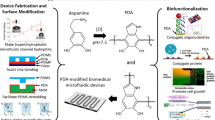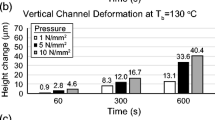Abstract
The trapping and deflection of biological cells by dielectrophoresis (DEP) at field non-uniformities in a microfluidic device is often conducted in a contactless dielectrophoresis (cDEP) mode, wherein the electrode channel is in a different layer than the sample channel, so that field penetration through the interceding barrier causes DEP above critical cut-off frequencies. In this manner, through physical separation of the electrode and sample channels, it is possible to spatially modulate electric fields with no electrode-induced damage to biological cells in the sample channel. However, since this device requires interlayer alignment of the electrode to sample channel and needs to maintain a thin interceding barrier (~ 15 μm) over the entire length over which DEP is needed (~ 1 cm), variations in alignment and microstructure fidelity cause wide variations in cDEP trapping level and frequency response across devices. We present a strategy to eliminate interlayer alignment by fabricating self-aligned electrode and sample channels, simultaneously with the interceding barrier layer (14-μm width and 50-μm depth), using a single-layer imprint and bond process on cyclic olefin copolymer. Specifically, by designing support structures, we preserve fidelity of the high aspect ratio insulating posts in the sample channel and the interceding barrier between the sample and electrode channels over the entire device footprint (~ 1 cm). The device operation is validated based on impedance measurements to quantify field penetration through the interceding barrier and by DEP trapping measurements. The presented fabrication strategy can eventually improve cDEP device manufacturing protocols to enable more reproducible DEP performance.

Graphical abstract






Similar content being viewed by others
References
Murphy TW, Zhang Q, Naler LB, Ma S, Lu C. Recent advances in the use of microfluidic technologies for single cell analysis. Analyst. 2018;143(1):60–80.
Luo T, Fan L, Zhu R, Sun D. Microfluidic single-cell manipulation and analysis: methods and applications. Micromachines. 2019;10(2):104.
Varhue WB, Langman L, Kelly-Goss M, Lataillade M, Brayman KL, Peirce-Cottler S, et al. Deformability-based microfluidic separation of pancreatic islets from exocrine acinar tissue for transplant applications. Lab Chip. 2017;17(21):3682–91.
McGrath J, Honrado C, Moore J, Adair S, Varhue W, Salahi A, et al. Electrophysiology-based stratification of pancreatic tumorigenicity by label-free single-cell impedance cytometry. Anal Chim Acta. 2020;1101:90–8.
Jones TB. Electromechanics of particles. Cambridge University Press; 2005.
Morgan H, Green NG. AC electrokinetics: colloids and nanoparticles. Research Studies Press; 2003.
Rohani A, Sanghavi BJ, Salahi A, Liao K-T, Chou C-F, Swami NS. Frequency-selective electrokinetic enrichment of biomolecules in physiological media based on electrical double-layer polarization. Nanoscale. 2017;9(33):12124–31.
Kim D, Luo J, Arriaga EA, Ros A. Deterministic ratchet for sub-micrometer (bio) particle separation. Anal Chem. 2018;90(7):4370–9.
Moore JH, Varhue WB, Su Y-H, Linton SS, Farmehini V, Fox TE, et al. Conductance-based biophysical distinction and microfluidic enrichment of nanovesicles derived from pancreatic tumor cells of varying invasiveness. Anal Chem. 2019;91(16):10424–31.
Fernandez RE, Rohani A, Farmehini V, Swami NS. Microbial analysis in dielectrophoretic microfluidic systems. Anal Chim Acta. 2017;966:11–33.
Rohani A, Moore JH, Kashatus JA, Sesaki H, Kashatus DF, Swami NS. Label-free quantification of intracellular mitochondrial dynamics using dielectrophoresis. Anal Chem. 2017;89(11):5757–64.
Burgarella S, Merlo S, Figliuzzi M, Remuzzi A. Isolation of Langerhans islets by dielectrophoresis. Electrophoresis. 2013;34(7):1068–75.
Hunt TP, Issadore D, Westervelt RM. Integrated circuit/microfluidic chip to programmably trap and move cells and droplets with dielectrophoresis. Lab Chip. 2008;8(1):81–7.
Barbulovic-Nad I, Xuan X, Lee JS, Li D. DC-dielectrophoretic separation of microparticles using an oil droplet obstacle. Lab Chip. 2006;6(2):274–9.
Lapizco-Encinas BH. On the recent developments of insulator-based dielectrophoresis: a review. Electrophoresis. 2019;40(3):358–75.
Li M, Anand RK. Integration of marker-free selection of single cells at a wireless electrode array with parallel fluidic isolation and electrical lysis. Chem Sci. 2019;10(5):1506–13.
Reale R, De Ninno A, Businaro L, Bisegna P, Caselli F. A simple electrical approach to monitor dielectrophoretic focusing of particles flowing in a microchannel. Electrophoresis. 2019;40(10):1400–7.
Sanghavi BJ, Varhue W, Chávez JL, Chou C-F, Swami NS. Electrokinetic preconcentration and detection of neuropeptides at patterned graphene-modified electrodes in a nanochannel. Anal Chem. 2014;86(9):4120–5.
Hanson C, Barney JT, Bishop MM, Vargis E. Simultaneous isolation and label-free identification of bacteria using contactless dielectrophoresis and Raman spectroscopy. Electrophoresis. 2019;40(10):1446–56.
Shafiee H, Caldwell JL, Sano MB, Davalos RV. Contactless dielectrophoresis: a new technique for cell manipulation. Biomed Microdevices. 2009;11(5):997.
Salmanzadeh A, Romero L, Shafiee H, Gallo-Villanueva RC, Stremler MA, Cramer SD, et al. Isolation of prostate tumor initiating cells (TICs) through their dielectrophoretic signature. Lab Chip. 2012;12(1):182–9.
Gwon HR, Chang ST, Choi CK, Jung JY, Kim JM, Lee SH. Development of a new contactless dielectrophoresis system for active particle manipulation using movable liquid electrodes. Electrophoresis. 2014;35(14):2014–21.
Jen C-P, Maslov NA, Shih H-Y, Lee Y-C, Hsiao F-B. Particle focusing in a contactless dielectrophoretic microfluidic chip with insulating structures. Microsyst Technol. 2012;18(11):1879–86.
Chen C-C, Lin P-H, Chung C-K. Microfluidic chip for plasma separation from undiluted human whole blood samples using low voltage contactless dielectrophoresis and capillary force. Lab Chip. 2014;14(12):1996–2001.
Rahmani A, Mohammadi A, Kalhor HR. A continuous flow microfluidic device based on contactless dielectrophoresis for bioparticles enrichment. Electrophoresis. 2018;39(3):445–55.
Podoynitsyn SN, Sorokina ON, Klimov MA, Levin II, Simakin SB. Barrier contactless dielectrophoresis: a new approach to particle separation. Sep Sci Plus. 2019;2(2):59–68.
Hanson C, Vargis E. Alternative cDEP design to facilitate cell isolation for identification by Raman spectroscopy. Sensors (Basel). 2017;17(2):327.
Čemažar J, Douglas TA, Schmelz EM, Davalos RV. Enhanced contactless dielectrophoresis enrichment and isolation platform via cell-scale microstructures. Biomicrofluidics. 2016;10(1):014109.
Sano MB, Salmanzadeh A, Davalos RV. Multilayer contactless dielectrophoresis: theoretical considerations. Electrophoresis. 2012;33(13):1938–46.
Cottet J, Vaillier C, Buret F, Frénéa-Robin M, Renaud P. A reproducible method for μ m precision alignment of PDMS microchannels with on-chip electrodes using a mask aligner. Biomicrofluidics. 2017;11(6):064111.
Nunes PS, Ohlsson PD, Ordeig O, Kutter JP. Cyclic olefin polymers: emerging materials for lab-on-a-chip applications. Microfluid Nanofluid. 2010;9(2–3):145–61.
Aghvami SA, Opathalage A, Zhang Z, Ludwig M, Heymann M, Norton M, et al. Rapid prototyping of cyclic olefin copolymer (COC) microfluidic devices. Sensors Actuators B Chem. 2017;247:940–9.
Lamonte RR, McNally D. Cyclic olefin copolymers. Adv Mater Process. 2001;159(3):33–6.
Farmehini V, Varhue W, Salahi A, Hyler AR, Čemažar J, Davalos R, et al. On-chip impedance for quantifying parasitic voltages during AC electrokinetic trapping. IEEE Trans Biomed Eng. 2019. https://doi.org/10.1109/TBME.2019.2942572.
Cohen CA, Shea AA, Heffron CL, Schmelz EM, Roberts PC. The parity-associated microenvironmental niche in the omental fat band is refractory to ovarian cancer metastasis. Cancer Prev Res. 2013;6(11):1182–93.
Creekmore AL, Silkworth WT, Cimini D, Jensen RV, Roberts PC, Schmelz EM. Changes in gene expression and cellular architecture in an ovarian cancer progression model. PLoS One. 2011;6(3):e17676.
Roberts PC, Mottillo EP, Baxa AC, Heng HH, Doyon-Reale N, Gregoire L, et al. Sequential molecular and cellular events during neoplastic progression: a mouse syngeneic ovarian cancer model. Neoplasia. 2005;7(10):944.
Simon MG, Li Y, Arulmoli J, McDonnell LP, Akil A, Nourse JL, et al. Increasing label-free stem cell sorting capacity to reach transplantation-scale throughput. Biomicrofluidics. 2014;8(6):064106.
Adams TN, Jiang AY, Vyas PD, Flanagan LA. Separation of neural stem cells by whole cell membrane capacitance using dielectrophoresis. Methods. 2018;133:91–103.
Taylor LC, Lavrik NV, Sepaniak MJ. High-aspect-ratio, silicon oxide-enclosed pillar structures in microfluidic liquid chromatography. Anal Chem. 2010;82(22):9549–56.
Farmehini V, Rohani A, Su Y-H, Swami NS. A wide-bandwidth power amplifier for frequency-selective insulator-based dielectrophoresis. Lab Chip. 2014;14(21):4183–7.
Funding
This study was funded by the US AFOSR contract FA2386-18-1-4100, the CytoRecovery, Inc., the Virginia Catalyst (VBHRC), and the National Center for Advancing Translational Sciences of the National Institutes of Health, under Award Number UL1TR003015.
Author information
Authors and Affiliations
Contributions
The manuscript was written through contributions of all authors and all authors approved the final version.
Corresponding author
Ethics declarations
Conflicts of interest
Co-author ARH is an employee of CytoRecovery, Inc. and co-author RVD is on the company’s Scientific Advisory Board. All other authors have no conflicts to declare.
Disclaimer
The content is solely the responsibility of the authors and does not necessarily represent the official views of the National Institutes of Health.
Additional information
Published in the topical collection Bioanalytics and Higher Order Electrokinetics with guest editors Mark A. Hayes and Federica Caselli.
Publisher’s note
Springer Nature remains neutral with regard to jurisdictional claims in published maps and institutional affiliations.
Electronic supplementary material
ESM 1
(PDF 2241 kb).
Rights and permissions
About this article
Cite this article
Salahi, A., Varhue, W.B., Farmehini, V. et al. Self-aligned microfluidic contactless dielectrophoresis device fabricated by single-layer imprinting on cyclic olefin copolymer. Anal Bioanal Chem 412, 3881–3889 (2020). https://doi.org/10.1007/s00216-020-02667-9
Received:
Revised:
Accepted:
Published:
Issue Date:
DOI: https://doi.org/10.1007/s00216-020-02667-9




